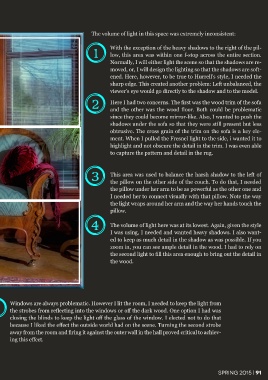Page 91 - NyghtVision Magazine Volume 5 #2
P. 91
The volume of light in this space was extremely inconsistent:
1 With the exception of the heavy shadows to the right of the pil-
low, this area was within one f-stop across the entire section.
Normally, I will either light the scene so that the shadows are re-
moved, or, I will design the lighting so that the shadows are soft-
ened. Here, however, to be true to Hurrell's style, I needed the
sharp edge. This created another problem: Left unbalanced, the
viewer's eye would go directly to the shadow and to the model.
2 Here I had two concerns. The first was the wood trim of the sofa
and the other was the wood floor. Both could be problematic
since they could become mirror-like. Also, I wanted to push the
shadows under the sofa so that they were still present but less
obtrusive. The cross grain of the trim on the sofa is a key ele-
ment. When I pulled the Fresnel light to the side, i wanted it to
highlight and not obscure the detail in the trim. I was even able
to capture the pattern and detail in the rug.
3 This area was used to balance the harsh shadow to the left of
the pillow on the other side of the couch. To do that, I needed
the pillow under her arm to be as powerful as the other one and
I needed her to connect visually with that pillow. Note the way
the light wraps around her arm and the way her hands touch the
pillow.
4 The volume of light here was at its lowest. Again, given the style
I was using, I needed and wanted heavy shadows. I also want-
ed to keep as much detail in the shadow as was possible. If you
zoom in, you can see ample detail in the wood. I had to rely on
the second light to fill this area enough to bring out the detail in
the wood.
6 Windows are always problematic. However I lit the room, I needed to keep the light from
the strobes from reflecting into the windows or off the dark wood. One option I had was
closing the blinds to keep the light off the glass of the window. I elected not to do that
because I liked the effect the outside world had on the scene. Turning the second strobe
away from the room and firing it against the outer wall in the hall proved critical to achiev-
ing this effect.
Spring 2015 | 91

